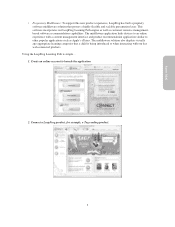LeapFrog 2007 Annual Report Download - page 19
Download and view the complete annual report
Please find page 19 of the 2007 LeapFrog annual report below. You can navigate through the pages in the report by either clicking on the pages listed below, or by using the keyword search tool below to find specific information within the annual report.
“Item 1A—Risk Factors—Our business is seasonal, and therefore our annual operating results depend, in large
part, on sales relating to the brief holiday season.” in this report.
Intellectual Property and Licensing
We rely on a combination of patent, trademark, copyright and trade secret laws in the United States and
other jurisdictions as well as confidentiality procedures and contractual provisions to protect our brand and our
proprietary technology and information.
We maintain an active program to protect our investment in technology and brands by attempting to secure
patent rights, trademark registrations and other intellectual property registrations. We have filed and obtained a
number of patents in the United States and abroad. We believe that the duration of the applicable patents we are
granted is adequate relative to the expected lives of our products. While our patents are an important element of
the protection of our intellectual property, our business as a whole is not materially dependent on any one patent.
For a discussion of how our intellectual property rights may not prevent our competitors from using similar
or identical technology, see “Item 1A—Risk Factors—Our intellectual property rights may not prevent our
competitors from using our technologies or similar technologies to develop competing products, which could
weaken our competitive position and harm our operating results.” in this report. For a discussion of how our
intellectual property rights may not insulate us from claims of infringement by third parties, see “Item 1A.—Risk
Factors—Third parties have claimed, and may claim in the future, that we are infringing their intellectual
property rights, which may cause us to incur significant litigation or licensing expenses or to stop selling some of
our products or using some of our trademarks.” in this report.
We also have a content licensing program where we both license other companies’ intellectual property for
use in our products and we license to other companies our intellectual property to create products. Examples
include the following:
•In-bound Licensing: We license a portion of our content from third parties under exclusive and
nonexclusive agreements, which allow us to utilize characters, stories, illustrations and trade names
throughout specified geographic territories. Examples include Disney/Pixar’s popular movie licenses
such as Cars, Nickelodeon’s television programming such as Dora the Explorer, and classic books such
as “Olivia” and “The Little Engine That Could.” LeapFrog currently has license agreements with
Disney, Nickelodeon, Warner Brothers, Cartoon Network and HIT Entertainment. Licenses are typically
limited to use of the licensed content in specific products for specific time periods. Significant portions
of the software content for our platforms contain content that is licensed from third parties. Our
continued use of these rights is dependent on our ability to continue to obtain license rights at reasonable
rates.
•Out-bound Licensing: We license our trademarks or service marks to third parties for manufacturing,
marketing, distribution and sale of various products. Our licensing strategy concentrates on extending
our current brand and developing brands into product categories that are consistent with our core
commitment to the design and development of educational products that make learning fun and
engaging. Our program of LeapFrog-branded products is designed to expand the product range available
to all of our consumers. Our licensing program of LeapFrog-branded products includes books from
Scholastic Corporation, ride-on toys from Kiddieland, card and board games from Cardinal, puzzles
from Masterpieces, and workbooks from Learning Horizons. Revenues from out-bound licensing were
not material in 2007 or 2006.
Research and Development
Our research and development expense was $59.4 million in 2007, $54.5 million in 2006 and $52.3 million
in 2005.
11
























